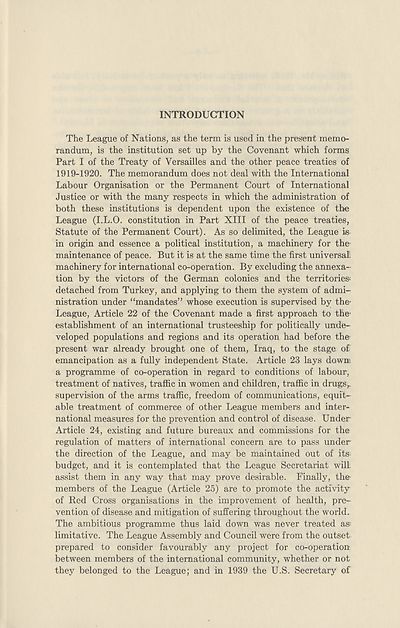Download files
Complete book:
Individual page:
Thumbnail gallery: Grid view | List view

INTRODUCTION
The League of Nations, as the term is used in the present memo¬
randum, is the institution set up by the Covenant which forms
Part I of the Treaty of Versailles and the other peace treaties of
1919-1920. The memorandum does not deal with the International
Labour Organisation or the Permanent Court of International
Justice or with the many respects in which the administration of
both these institutions is dependent upon the existence of the
League (I.L.O. constitution in Part XIII of the peace treaties,
Statute of the Permanent Court). As so delimited, the League is
in origin and essence a political institution, a machinery for the
maintenance of peace. But it is at the same time the first universal
machinery for international co-operation. By excluding the annexa¬
tion by the victors of the German colonies and the territories-
detached from Turkey, and applying to them the system of admi¬
nistration under “mandates” whose execution is supervised by the
League, Article 22 of the Covenant made a first approach to the
establishment of an international trusteeship for politically unde¬
veloped populations and regions and its operation had before the
present war already brought one of them, Iraq, to the stage of
emancipation as a fully independent State. Article 23 lays down:
a programme of co-operation in regard to conditions of labour,
treatment of natives, traffic in women and children, traffic in drugsr
supervision of the arms traffic, freedom of communications, equit¬
able treatment of commerce of other League members and inter¬
national measures for the prevention and control of disease. Under
Article 24, existing and future bureaux and commissions for the
regulation of matters of international concern are to pass under-
the direction of the League, and may be maintained out of its
budget, and it is contemplated that the League Secretariat will,
assist them in any way that may prove desirable. Finally, the
members of the League (Article 25) are to promote the activity
of Red Cross organisations in the improvement of health, pre¬
vention of disease and mitigation of suffering throughout the world.
The ambitious programme thus laid down was never treated as
limitative. The League Assembly and Council were from the outset
prepared to consider favourably any project for co-operation
between members of the international community, whether or not
they belonged to the League; and in 1939 the U.S. Secretary of
The League of Nations, as the term is used in the present memo¬
randum, is the institution set up by the Covenant which forms
Part I of the Treaty of Versailles and the other peace treaties of
1919-1920. The memorandum does not deal with the International
Labour Organisation or the Permanent Court of International
Justice or with the many respects in which the administration of
both these institutions is dependent upon the existence of the
League (I.L.O. constitution in Part XIII of the peace treaties,
Statute of the Permanent Court). As so delimited, the League is
in origin and essence a political institution, a machinery for the
maintenance of peace. But it is at the same time the first universal
machinery for international co-operation. By excluding the annexa¬
tion by the victors of the German colonies and the territories-
detached from Turkey, and applying to them the system of admi¬
nistration under “mandates” whose execution is supervised by the
League, Article 22 of the Covenant made a first approach to the
establishment of an international trusteeship for politically unde¬
veloped populations and regions and its operation had before the
present war already brought one of them, Iraq, to the stage of
emancipation as a fully independent State. Article 23 lays down:
a programme of co-operation in regard to conditions of labour,
treatment of natives, traffic in women and children, traffic in drugsr
supervision of the arms traffic, freedom of communications, equit¬
able treatment of commerce of other League members and inter¬
national measures for the prevention and control of disease. Under
Article 24, existing and future bureaux and commissions for the
regulation of matters of international concern are to pass under-
the direction of the League, and may be maintained out of its
budget, and it is contemplated that the League Secretariat will,
assist them in any way that may prove desirable. Finally, the
members of the League (Article 25) are to promote the activity
of Red Cross organisations in the improvement of health, pre¬
vention of disease and mitigation of suffering throughout the world.
The ambitious programme thus laid down was never treated as
limitative. The League Assembly and Council were from the outset
prepared to consider favourably any project for co-operation
between members of the international community, whether or not
they belonged to the League; and in 1939 the U.S. Secretary of
Set display mode to:
![]() Universal Viewer |
Universal Viewer | ![]() Mirador |
Large image | Transcription
Mirador |
Large image | Transcription
Images and transcriptions on this page, including medium image downloads, may be used under the Creative Commons Attribution 4.0 International Licence unless otherwise stated. ![]()
| League of Nations > Legal > Powers and duties attributed to the League of Nations by international treaties > (7) |
|---|
| Permanent URL | https://digital.nls.uk/191396300 |
|---|
| Shelfmark | LN.V |
|---|
| Description | Over 1,200 documents from the non-political organs of the League of Nations that dealt with health, disarmament, economic and financial matters for the duration of the League (1919-1945). Also online are statistical bulletins, essential facts, and an overview of the League by the first Secretary General, Sir Eric Drummond. These items are part of the Official Publications collection at the National Library of Scotland. |
|---|---|
| Additional NLS resources: |
|

